Spiti Behind The Scenes
10N/11D days
July , Aug , Sep
Availability 15
$1500
Per Person
OVERVIEW
Spiti Valley, with an average height of 12,500 feet above sea level, is a desert mountain which lies nestled between India and Tibet. With clear shinning blue skies, snow-capped mountains piercing up and turquoise green streams. this 10 day Spiti Valley and Kinnaur round trip on the Hindustan-Tibet highway and the Manali – Kaza highway is by far the most unforgettable drives you’ll take in your life.
The Spiti Valley is a desert mountain valley located high in the Himalaya mountains in the north-eastern part of theIndian state of Himachal Pradesh. The name “Spiti” means “The Middle Land”, i.e. the land between Tibet and India.
Spiti valley is accessible throughout year via Kinnaur from Shimla route on a difficult 412 km long road. Tourists from outside India need inner line permits to enter Spiti through Kinnaur. Spiti’s border start at Samdo [74 km from Kaza] which is quite near to India-China border. In summer it can be reached via Manali through Rohtang pass and Kunzum pass. Manali is 201 km away from Kaza headquarter of Spiti subdivision. Due to high elevation one is likely to feelaltitude sickness in Spiti.
Day 1-MANALI
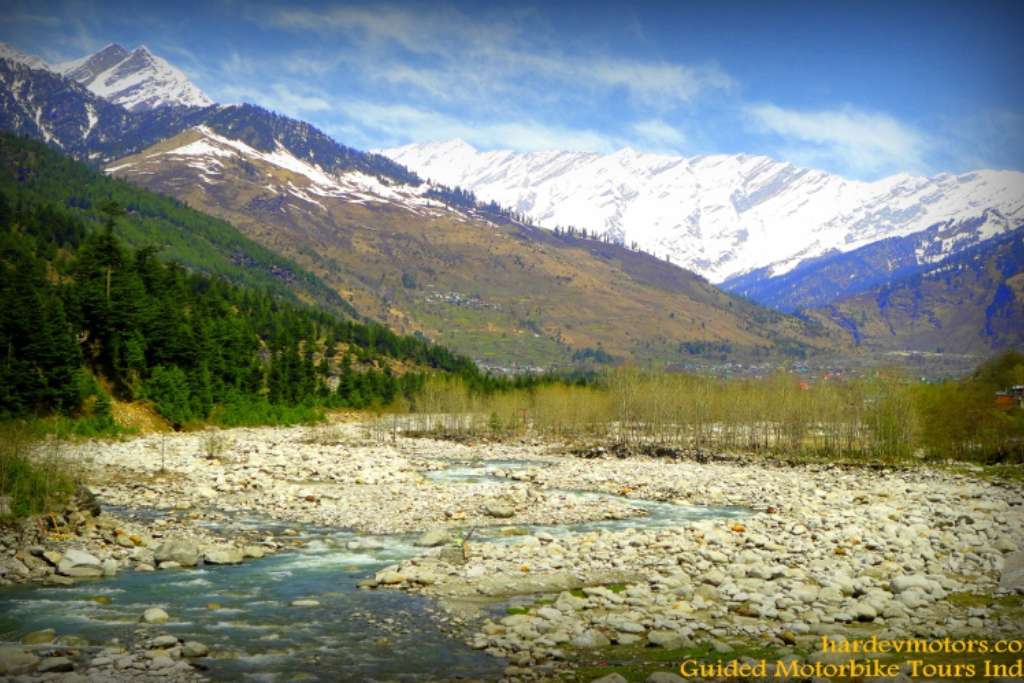
In morning we come to pick you up at the Kullu Airport or at the bus station and drive you to your hotel. Our representatives are there to provide you all the services and soon you’ll be introduced to the bikes and all details about the tour. Go-Pro Cameras on helmets, riding gears, Royal Enfield Bikes, let’s start riding around Manali valley with Adventure activities!
Day 2-Manali – Banjar
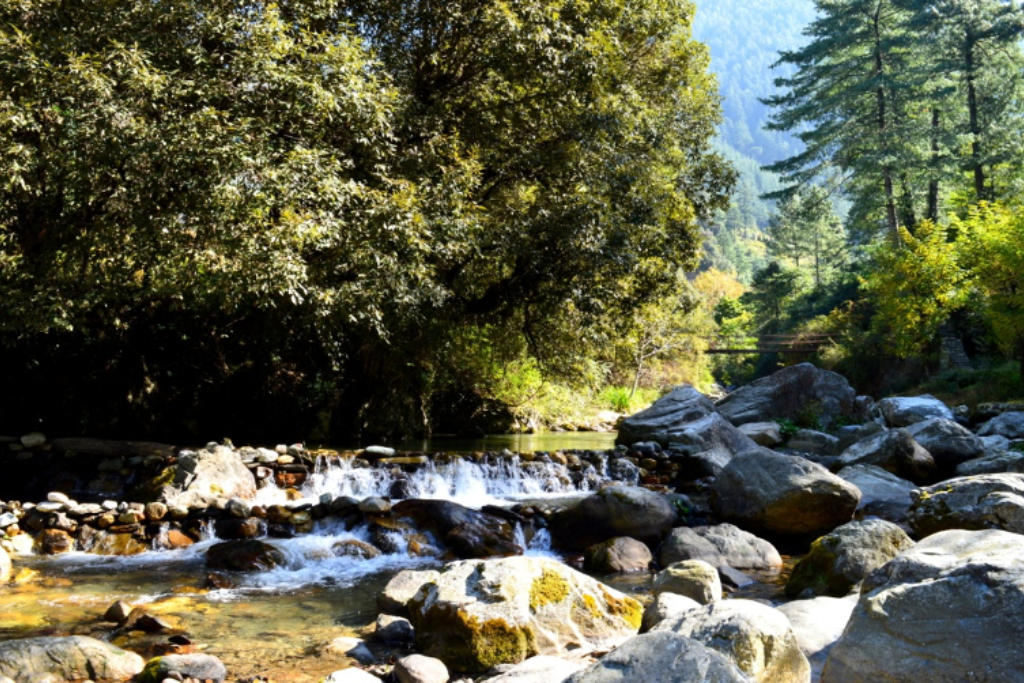
We begin our motorcycle trip in direction of Banjar Valley. Also known as the “Valley of Tranquility”, Banjar is noted for the splendid scenery, sparkling streams, lakes, meadows, thick forest, and high mountain ranges. Its beauty and its majestic hills covered with Pine and Deodar Forest and sprawling Apple Orchards will make you feel like in a veritable heaven upon earth.
Day 3-Banjar – Sarahan
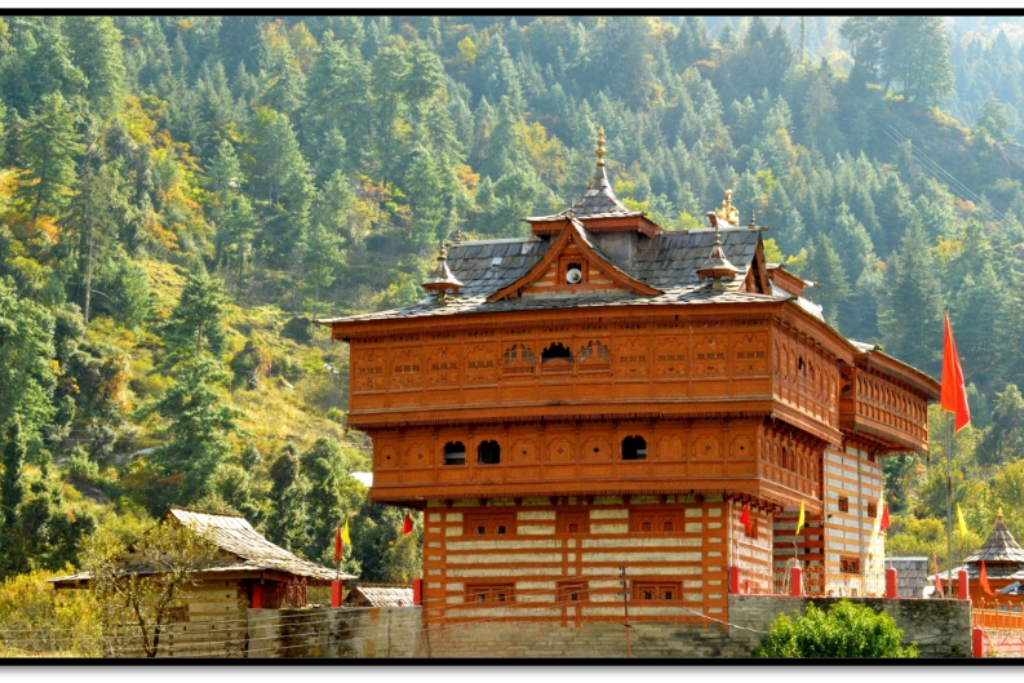
We follow our route in direction of Saharan, the gate way to Kinnaur. Known as the land of fairy tales and fantasies, Kinnaur has a spectacular terrain of lush green valley, orchards, vineyards, snow clad peaks and cold desert mountains. Kinnaur is extremely rich in flora & fauna and the culture and language is different from other parts of the state. Criss-crossing one of the most picturesque valley of the region, we follow the road to Sarahan which composes pictures of pastoral perfection, as the apple orchards gardens of rare medicinal herbs, a variety of wild flowers and fields surround the small hamlets with their slate roofed houses. A visit of Bhimakali temple is planned. The temples’ unusual architecture and wealth of carvings, have made it a resplendent example of pahari hill style.
Day 4 -Sarahan – Chitkul
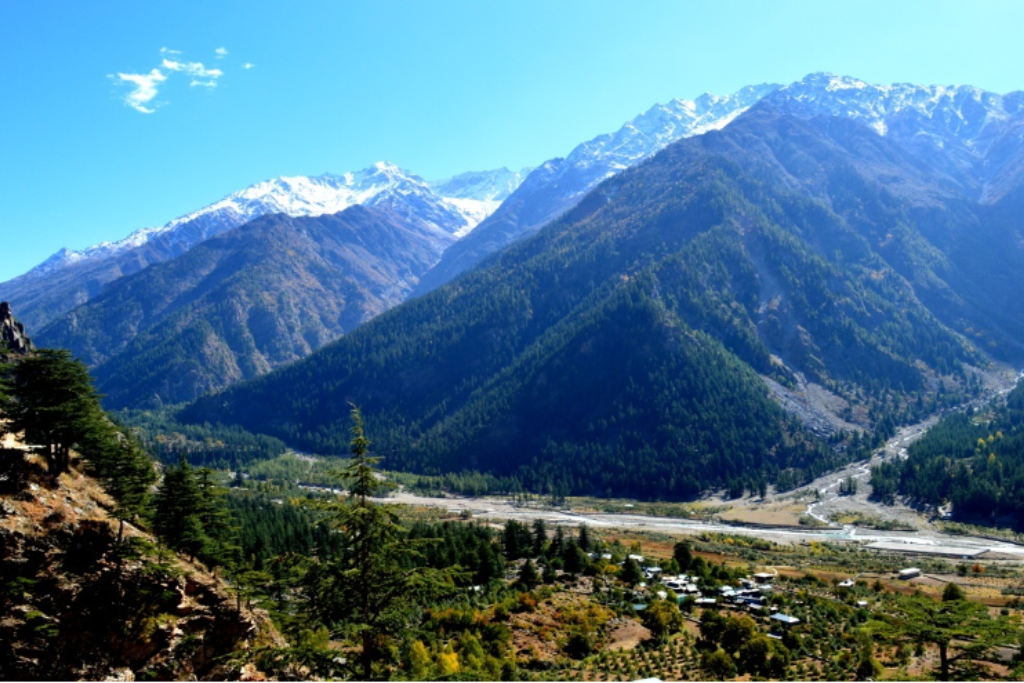
Head to Chitkul through the beautiful Sangla valley surrounded by thick forests, apple orchards, rushing waters and towering Himalayan ranges. Chitkul is the last inhabited village near the Indo-Tibet border and is renowned for its houses with either slate or wooden plank roofs, a Buddhist temple and a small tower.
Day 5-Chitkul – Kalpa
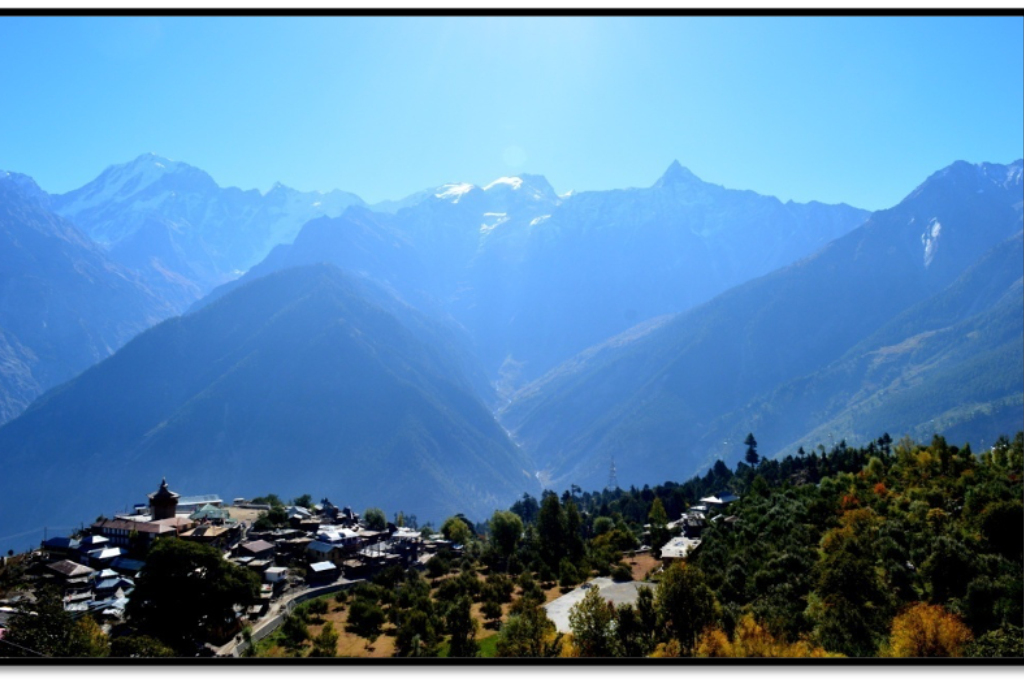
We take the road towards Kalpa, one of the biggest and beautiful villages of Kinnaur. Situated at the height of 2758 m above the sea level and 110 km from Sarahan, Kalpa is the main village of Kinnaur. Across the river faces the majestic mountains of the Kinner Kailash range. These are spectacular sights early in the morning as the rising sun touches the snowy peaks with crimson and golden light.
Day 6-Kalpa – Nako – Tabo

Ride to Nako. On the route an amazing change of scenery awaits you. From the greenery of the scenic valleys, you’ll move to the stark magnificence of the high cold desert. We’ll make a halt to Nako, 3600m altitude, where you’ll be immediately absorbed by the traditional atmosphere and architecture. Founded in 996 AD, the village looks like it hasn’t change in hundred of years. On the programme, visit of the old temples, founded in the 10th -11th century with fine sculptures and frescoes and a walk through the village and near its small and beautiful holy lake. After the visit, head to Tabo and visit of one of the most important Buddhist monasteries of the region. Founded in 996 CE, Tabo is the largest monastic complex of Spiti and has been declared a protected monument under the Archaeological Survey of India. It is here that the 14th Dalai Lama held the Kalachakra ceremonies in 1983 and 1996.
Day 7-Tabo – Kaza
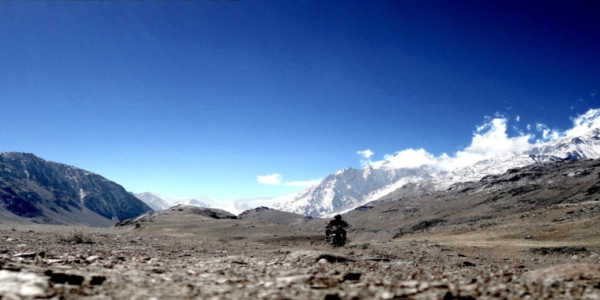
Gear up for the ride to Kaza, capital and regional headquarters of Spiti valley. With freckles of green over a dry, weather-beaten face, Spiti is a cold desert where the monsoon rain never comes. It is characterized by stark beauty, narrow valleys and high mountains. A century ago, Rudyard Kipling in Kim called Spiti “a world within a world” and a “place where the gods live” – a description that holds true to the present day.
Day 8-Kaza – Kibber – Komic – Kaza
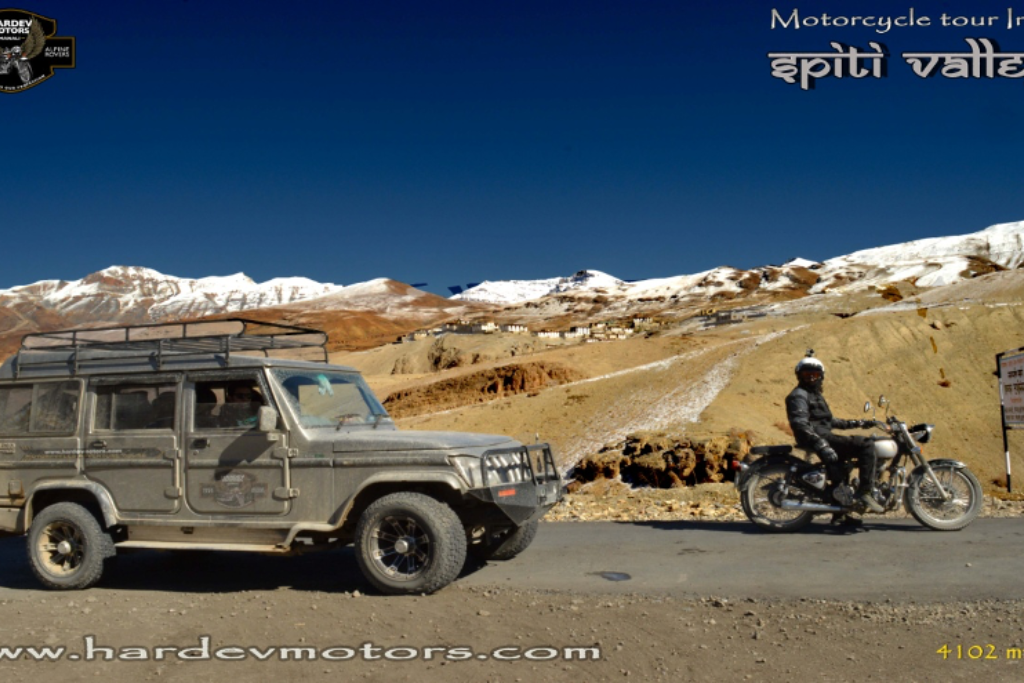
From Kaza, we’ll start riding to Kibber, the highest village of Asia. On the way, we’ll stop to “Key Monastery”, the largest monastery and most colorful in Spiti Valley. Established in the 11th century, the monastery has ancient Buddhist scrolls and paintings. Before reaching our next destination, we’ll make a halt in Langza village where we’ll climb to the large and colorfull Buddha statue overlooking Spiti valley and nicely contrasting with the dark brown mountains and stark blue sky. We follow our route towards Kibber. Located at an altitude of 4300m, Kibber has only 80 houses and plenty of cultivation that contrasts sharply with the arid backdrop of lofty hills. Wetake the road again in direction of Komic where, if we are lucky, we’ll be able to find some fossils near the streams flowing from the mountains. After our archeological excavations, back to Kaza.
Day 9-Kaza – Chandratal Lake

We take the road in direction of the next mother’s nature masterpiece! Chandratal Lake or “Moon Lake” is a breathtaking place situated at a height of 4300 m. The sweet water lake is around 2.5 km wide. It can be visited only during the three summer months. For the rest of the season, the lake remains cut off and frozen. This lake, changing colour with the colour of the sky, is surround by Chandra Bhaga mountain range which forms the perfect backdrop. This magic view will take your breath away.
Day 10-Chandratal Lake – Manali

Day 11-Manali (Departure)
End of the tour. In the morning, you are free to do some shopping for the family and friends. Shawls, Tweed jackets, costume jewelry, Tibetan handicrafts are the local arts and crafts that you can find easily in Manali and for a reasonable price. After lunch, a transfer to the New Delhi airport or Manali bus station will be organized by our team as per your schedule.
Departure
MANALI
Return Time
MANALI
Included
- Inner line permits/monuments entrance fee
- Corpsman
- Medicines
- Stickers of your Club on Motorcycles
- Backup Rider/Helper
- Oxygen Canister
- All toll and GST Taxes
- First Aid Kit
- Mobile chargers on Bike
- Back up vehicle
- Food MAP Basis
- Himalayan scram or Himalayan 450cc
- Accommodation ( 4 star + wherever applicable )
- English speaking guide
- Mineral water, Snacks, Dry fruits
- Team Leader
- BBQ night
- Medical assistance 24x7
- Photos and video of the whole trip.raw
Not Included
- All expenses of personal nature such as Alcohol, laundry etc.
- Motorbike damage will be covered from your Refundable security amount Personal insurance and evacuation charges Riding Gears.
- Any item not included in the above “INCLUSIONS”.
- Personal insurance and evacuation charges
- India Visa
- Riding Gears.
- Insurance against or for accidents/loss of life, loss of goods etc.
- Third party insurance.
- International /Domestic flights
- Tips to guides, drivers etc.
- Medical insurance/Travel insurance coverage
